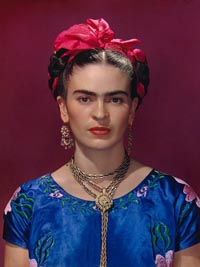The Dallas Museum of Art has provided a pop-up peek of its free exhibition Frida Kahlo: Five Works to downtown Garland. The outdoor installation at 506 Main Street (506 Art) is inspired by the celebrated Mexican artist’s home and museum in Mexico City and features reproductions of Still Life and Still Life with Parrot and Flag. These are two of Kahlo’s paintings currently on view at the DMA. Viewers are invited to discover more by visiting the free exhibition in person through June 20 or virtually at virtual.dma.org/fridakahlo.
Considered one of Mexico’s greatest artists, Frida Kahlo was born Magdalena Carmen Frieda (Frida) Kahlo y Calderón, in Coyoacán, Mexico City, on July 6, 1907. She grew up in the family home where she was born, later referred to as the Blue House (La Casa Azul). A bus accident in 1925 left her unable to bear a child, and she underwent 32 operations throughout her life. Pain and suffering are common themes she addresses in her art.
Conserving Kahlo
In preparation for this exhibition, three of the paintings were studied in the DMA’s paintings conservation studio. Using infrared photography, X-radiography and microscopic examination, novel information was brought to light regarding Still Life with Parrot and Flag from 1951, Sun and Life from 1947, and Diego and Frida 1929–1944 from 1944. Infrared photography allows conservators to look through surface-level paint to the underlying preparatory layers. X-radiography, on the other hand, enables us to visualize compositional changes made in paint. This combination of imaging provided a fascinating new perspective into Frida Kahlo’s working methods.
About the exhibition
Frida Kahlo: Five Works offers a rare chance to explore a selection of works by acclaimed Mexican painter Frida Kahlo. Since Kahlo’s death in 1954, her deeply emotional and vibrant paintings have garnered ever-increasing attention, transforming the celebrated artist into a global cultural phenomenon.
This installation features four paintings and a drawing on loan from a private collection, each acting as a vehicle for understanding larger aspects of Kahlo’s artistic practice, including her working methods and unique visual language. These works invite us to look closely, exploring their layered meanings and pondering their connections to Kahlo’s adventurous life.


